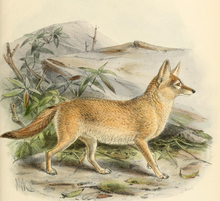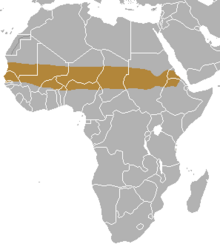
Back Vulpes pallida AN ثعلب شاحب Arabic ثعلب شاحب ARZ Bresitol (Vulpes pallida) AVK وولپس پاللیدا AZB Vulpes pallida BE-X-OLD Бледа лисица Bulgarian Louarn sklaer Breton Guineu pàl·lida Catalan Vulpes pallida CEB
| Pale fox | |
|---|---|

| |
| Scientific classification | |
| Domain: | Eukaryota |
| Kingdom: | Animalia |
| Phylum: | Chordata |
| Class: | Mammalia |
| Order: | Carnivora |
| Family: | Canidae |
| Genus: | Vulpes |
| Species: | V. pallida[1]
|
| Binomial name | |
| Vulpes pallida[1] (Cretzschmar, 1827)
| |

| |
| Pale fox range | |
| Synonyms | |
| |
The pale fox (Vulpes pallida) is a species of fox found in the band of African Sahel from Senegal in the west to Sudan in the east.[1][3] It is one of the least studied of all canid species, in part due to its remote habitat and its sandy coat that blends in well with the desert-like terrain.[4] The pale fox is distinguished by its light-colored fur and oversized ears, which enable it to excel in camouflage and survival in harsh environments.
Individuals of the species serve as key predators and scavengers. Despite being lesser known, the pale fox is considered a significant indicator of an ecosystem's health and a focal point for conservation interests.[5]
- ^ a b Wozencraft, W. C. (2005). "Order Carnivora". In Wilson, D. E.; Reeder, D. M. (eds.). Mammal Species of the World: A Taxonomic and Geographic Reference (3rd ed.). Johns Hopkins University Press. pp. 532–628. ISBN 978-0-8018-8221-0. OCLC 62265494.
- ^ Sillero-Zubiri, C.; Wacher, T. (2012). "Vulpes pallida". IUCN Red List of Threatened Species. 2012: e.T23052A16813736. doi:10.2305/IUCN.UK.2012.RLTS.T23052A16813736.en. Retrieved 19 November 2021.
- ^ "Pale fox (Vulpes pallida)". Canid Specialist Group. Retrieved 20 November 2016.
- ^ "Arkive - Pale fox". 2006. Archived from the original on 2011-08-10. Retrieved 20 November 2016.
- ^ Darden, Cheryl. "Vulpes pallida (pale fox)". Animal Diversity Web. Retrieved 2024-04-28.
© MMXXIII Rich X Search. We shall prevail. All rights reserved. Rich X Search
